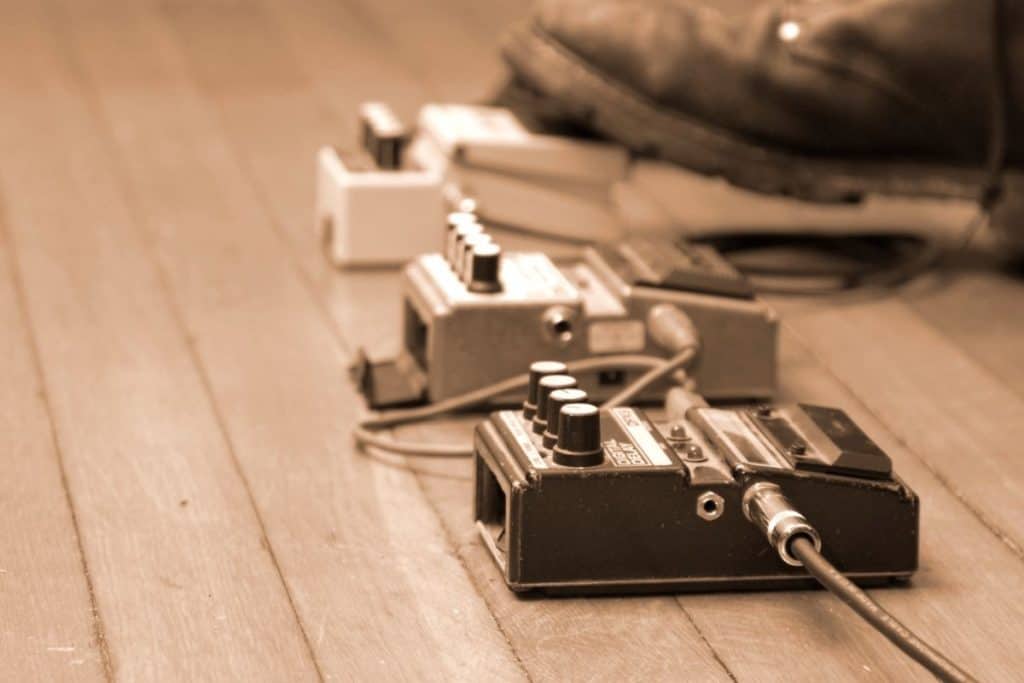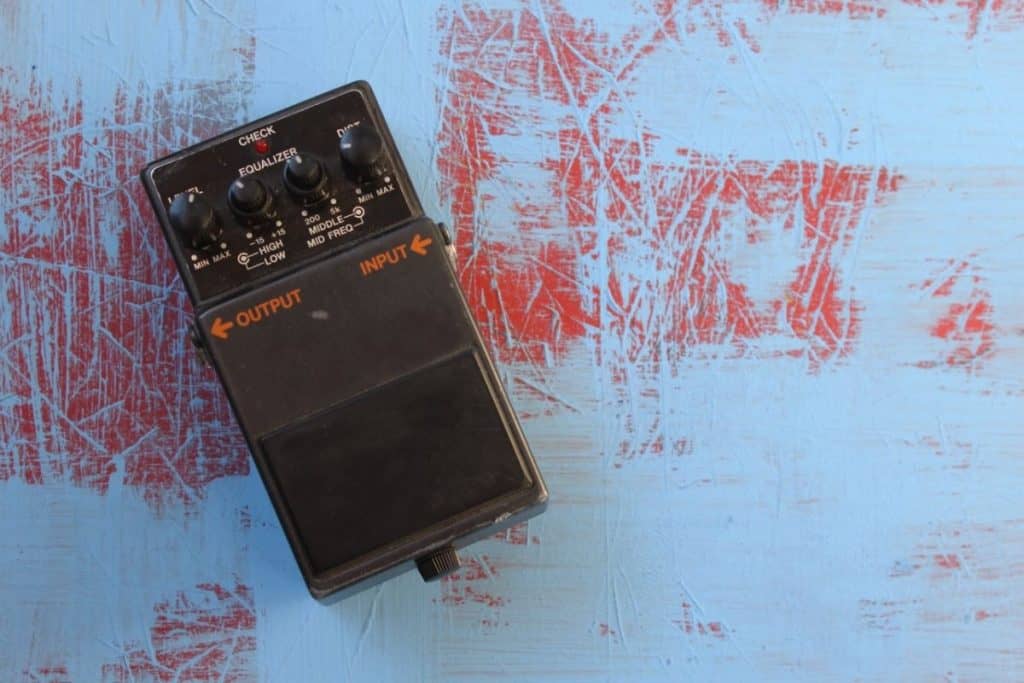If you like playing the sound of your electric guitar out through an amplifier, you may be aware that you can have the signal pass through lots of audio-altering pedals before it comes out of the amp.
In a very short amount of time, these change the qualities of the sound. These stages are known as the “chain”, but where should you put a boost pedal within it?

Well, we’ve got the answers for you! In our guide below, you’ll find out all about where the best place to position the boost pedal in the chain will be – as well as why. Read on!
What Is The Chain?
When we refer to “the chain” you may think of the Fleetwood Mac song of the same name, which is especially famous for its electric guitar solo.
In a way, it seems quite appropriate then for “the chain” to refer to a crucial part of the guitar amplification process.
Also known as the “signal chain”, the chain refers to the series of stages and elements that all work together to bring the electrical signal of your guitar sound all the way from its creation to its amplification through the amp.
Basically, guitarists add in a lot of tools (really, audio processors) that will change the nature of their guitar sound, altering it to be exactly how they want.
These are through the use of pedals, each of which brings a different twist to the overall type of sound that you’re getting.
What begins just as you picking a note on your guitar, is then changed in a specific sequence by all these audio processors, before coming out as an altered sound through the amp.
To our ears, it sounds instant, but really a lot of very precise, very quick changes have gone on.
Types Of Pedals In The Chain
What are some of these pedals and what do they do? Well, you can include pedals which shape the tone of the guitar, as well as a compressor pedal to enhance the sound, and a buffer pedal that preserves the strength of the guitar signal.
On top of that, an overdrive pedal can be added to create an almost crunchy, soft tone, or a distortion pedal can even be applied. You can probably guess what that last one does!
It distorts the sound, giving it a heavy rock type feel and a bit of scuzz and scrape.
Additionally, modulation pedals can be added, which come in many different varieties and all bring different twists to them, changing the depth and movement of the guitar sound.
One of these depth-adding pedals is the phaser pedals, which adds depth but doesn’t add extra gain to the noise.
Another modulation pedal is the chorus pedal, which you can guess the effect of: it duplicates the signal to make it sound like there are multiple instruments playing at the same time.
Delay and reverb pedals can also be added in the signal chain. Delay pedals allow you to record and playback the music signals that are going into it, while a reverb pedal will emulate the effects that you would get from reverberation.
Finally, boost pedals are another type of processor you can add to your chain. But what are they?
What Is A Boost Pedal?

A boost pedal does exactly what it sounds like – it boosts the signal from your guitar. Effectively, it takes the guitar signal and intensifies it, before it reaches the amp.
However, there are a variety of boost pedals that you can buy and use in your signal chain. One of them is a “Clean Boost”, which will amplify your guitar signal, but do it without clipping the signal and instead keep the original tone of the instrument.
On the other hand, an “EQ Boost” will allow you to shape lots of different frequencies within your guitar noise, giving you a lot of flexibility with the tone of the sound.
For a different result, a “Pre-amp Booster can be used, which will not only amplify the signal, but also “color” the sound – which means change the quality of the audio that is not amplitude, pitch, or duration.
Additionally, a “Dirty Boost” will act like a Clean Boost, but can be pushed further and harder.
Finally, a “Treble Boost” will amplify the mid and top end frequencies of your guitar signal, but largely neglect the lower frequencies of it.
Where To Put A Boost Pedal In Chain
A boost pedal becomes more necessary the more other pedals you have, in order to keep the signal strength strong through them all. However, where you should put the boost pedal can vary.
The position can often depend on what part you’re exactly looking to boost, which pedal and which effect pon the signal.
However, placing it at the start of the chain can be a mistake. A boost pedal will add voltage to the chain, which may seem like a good thing, but some earlier-placed pedals may not be able to handle the increased voltage.
On the other hand, placing it at the end of the chain can be pointless.
This is because there’s no point adding voltage at the very end, when all the previous steps have lost their strength already, compromising the quality of the signal. Generally, always avoid the end.
As a result, it’s best to put the boost pedal a little after the start. Not too near to the middle, but not at the very beginning either.
Final Thoughts
A boost pedal can add a lot to your signal, preserving it as it goes through the other audio processors in your signal chain. Make sure to put it in a place that will benefit best the pedals around it!
Recent Posts
QuickTime is a vital app for many Mac users, and if you’ve recently bought a new microphone, you might wonder how to use it optimally. QuickTime cannot record audio content if it doesn’t have...
Every microphone leaves a unique signature on the quality of its output. If you’re a podcaster trying to melt your way into your audience’s hearts, a muddy, distorted recording won’t cut it....
